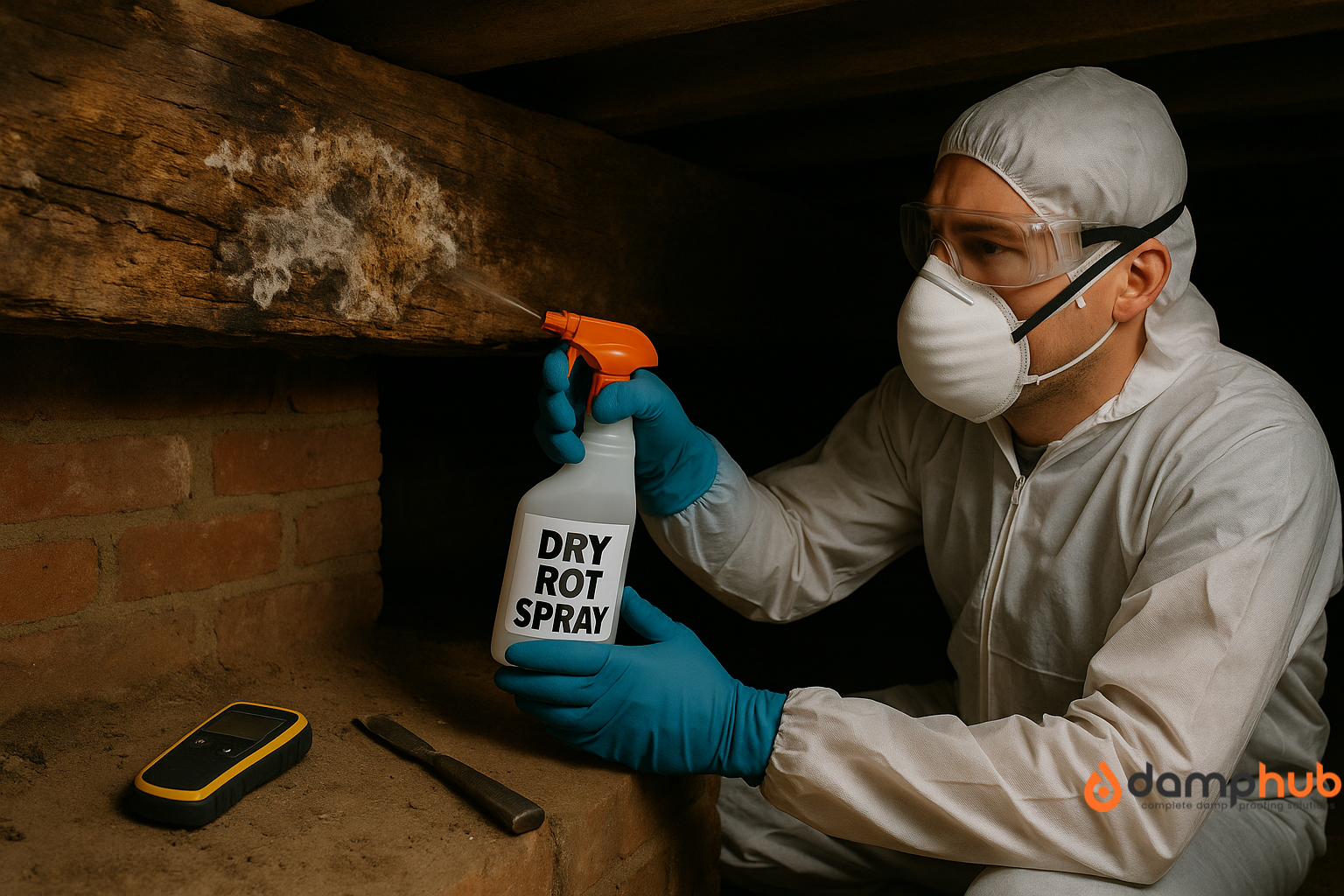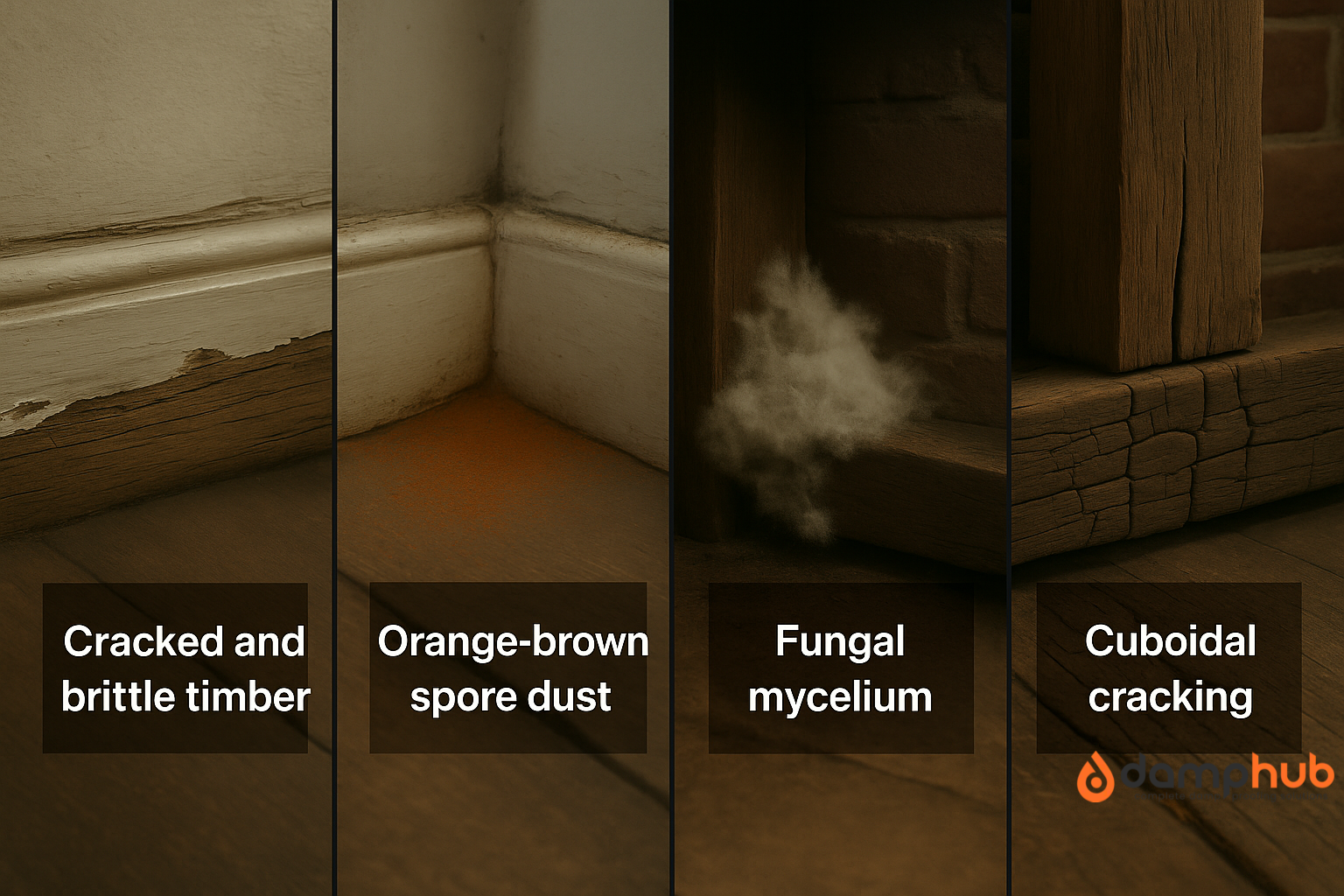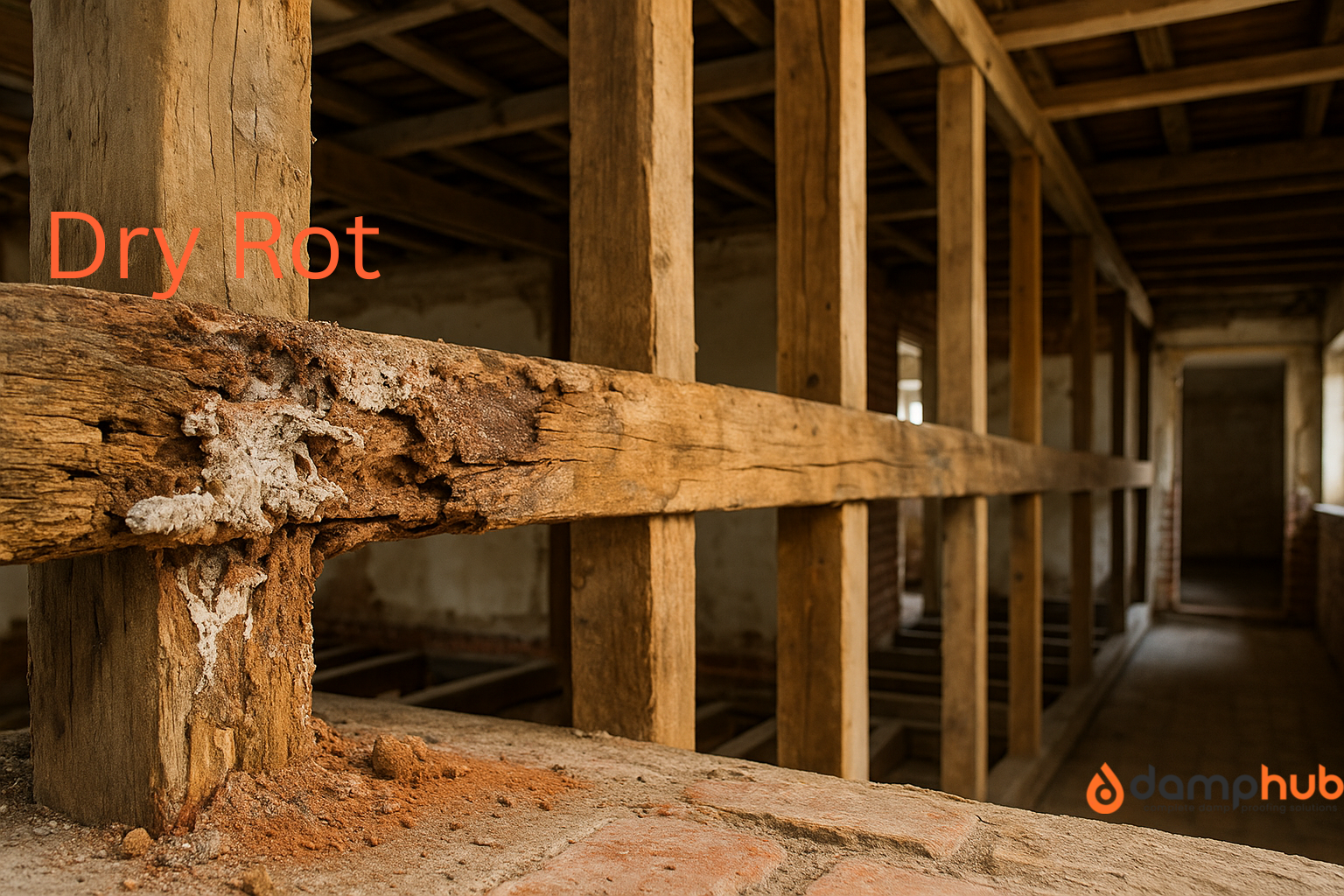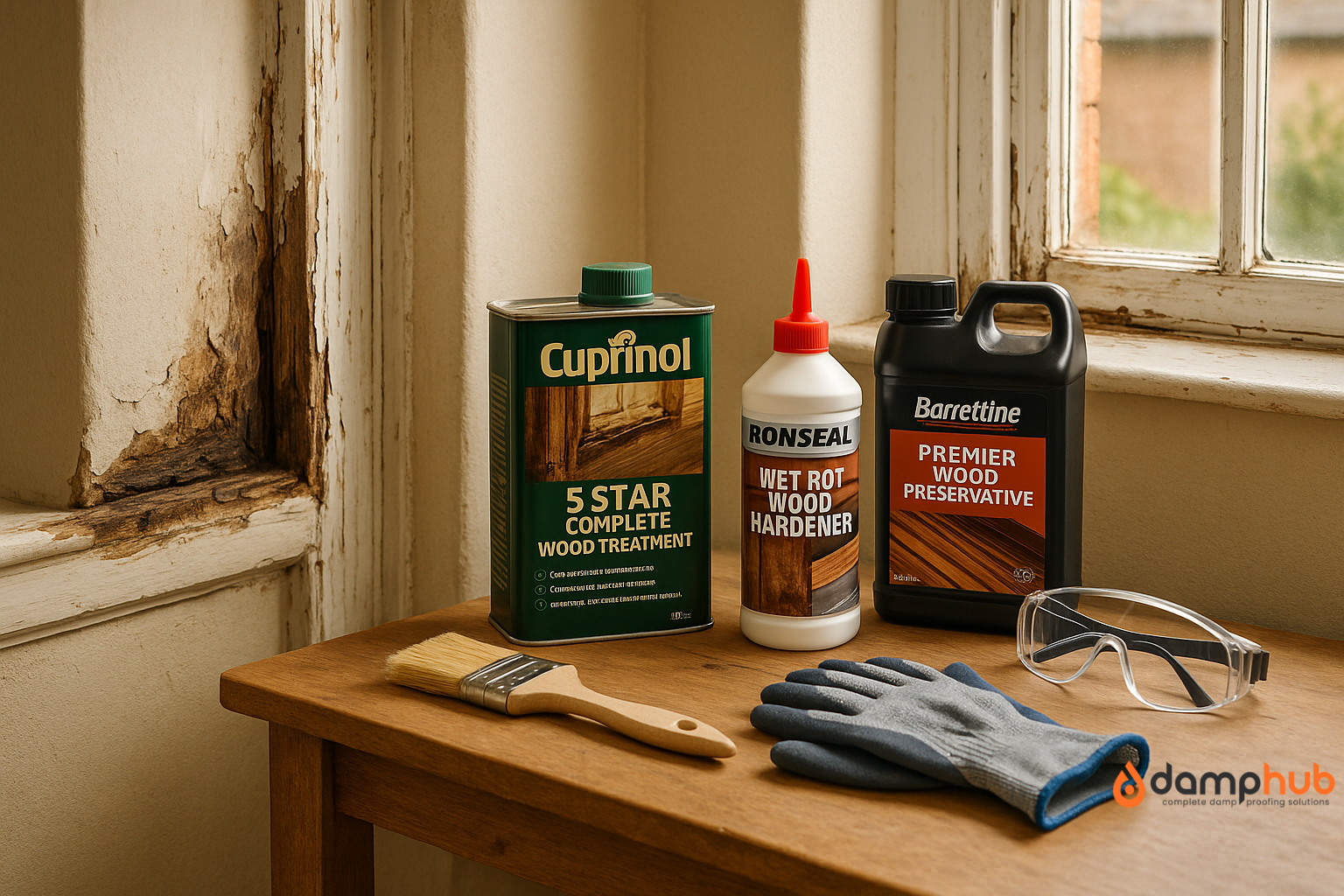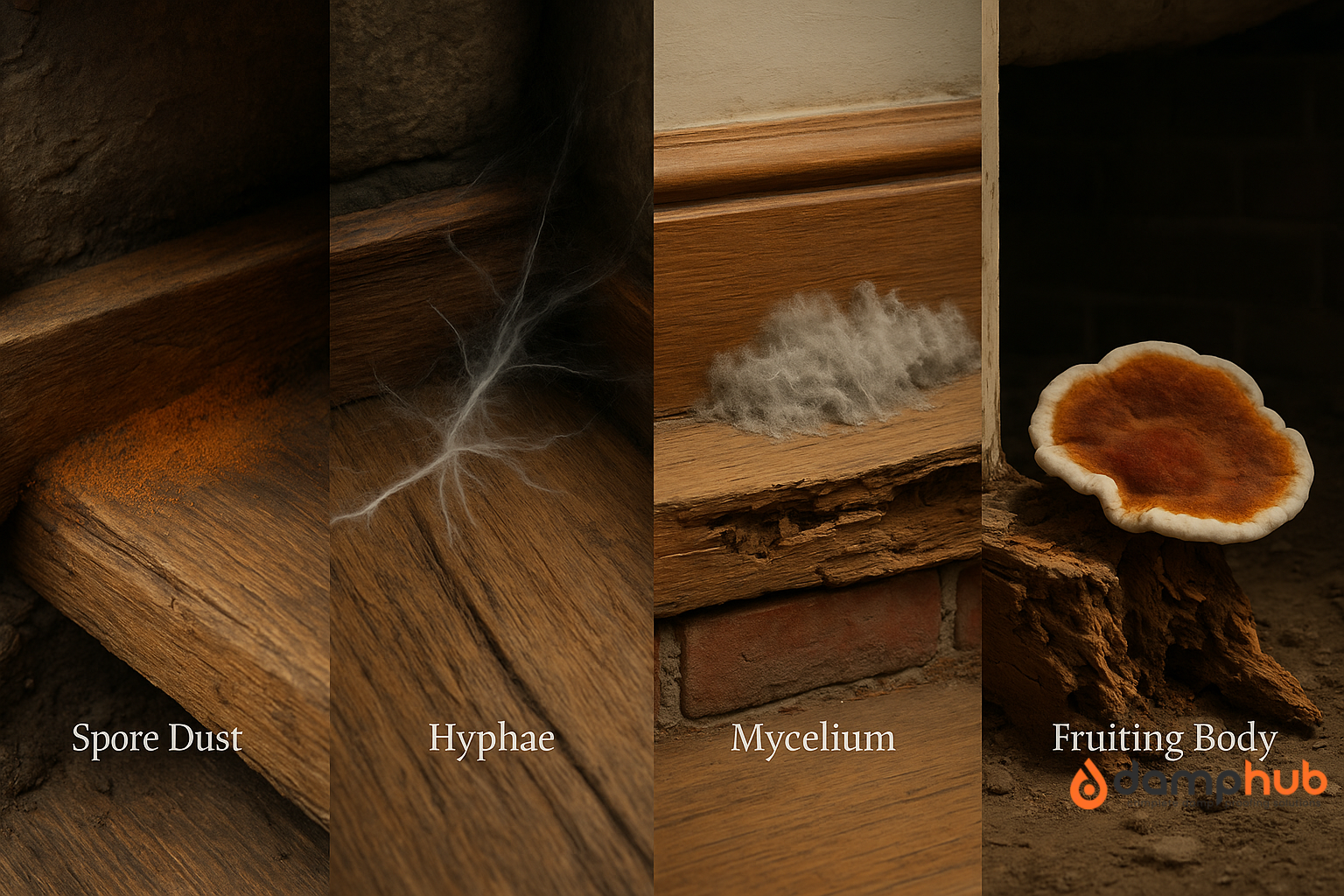
Dry rot doesn’t start with collapsing floors or mushroom-shaped growths. It starts quietly —a slow patch of trapped moisture in an old joist or floorboard. And once it gets going, it spreads fast.
The dry rot lifecycle is a living, breathing process caused by a fungus that invades timber, feeds on it, and sends out spores to start again elsewhere.
To stop it properly, you need to understand it properly. What causes it. Where it hides. And how to break the cycle before it takes hold. This is the essence of the dry rot lifecycle.
What Organism Causes Dry Rot?
Dry rot is caused by a fungus called Serpula lacrymans. It’s not a vague “type of rot” — it’s a very specific species, and it’s aggressive.
The fungus survives by feeding on cellulose and hemicellulose, the parts of timber that give it structure and strength. Once it finds damp enough timber, it releases enzymes that break the wood down into digestible sugars. In other words, it digests your house.
Here’s what makes dry rot so destructive:
- Its spores are airborne — always present, waiting for damp timber
- It can spread through masonry, not just wood
- It continues growing in dark, unventilated places, long after the source of moisture is fixed
Serpula lacrymans is clever, adaptable, and persistent. Left alone, it won’t just damage your timber — it can make parts of a building structurally unsafe. This stage of the dry rot lifecycle is where internal timber decay begins — long before most people notice.
Where Does Dry Rot Start?
Dry rot starts wherever there’s timber + damp + poor airflow. The fungus needs wood as a food source, moisture to activate its spores, and still air to help the hyphae and mycelium spread.
Typical starting points in UK homes include:
- Floor joists built into damp walls
- Understairs cupboards with poor ventilation
- Behind kitchen cabinets after a slow leak
- Timber lintels sitting above a failed damp-proof course
- Roof voids with hidden gutter leaks or missing lead flashing
- Bathroom floorboards under old, cracked tiles
It often begins in concealed, rarely disturbed areas, so by the time you notice a smell or visible patch, the fungus may have already spread extensively.
These are the early ignition points of the dry rot lifecycle, where moisture, timber, and still air combine to trigger spore activation.
💡 Pro Tip
- ✓ If timber is in contact with damp masonry — especially in older solid-wall homes — always suspect dry rot, even if the surface looks sound.
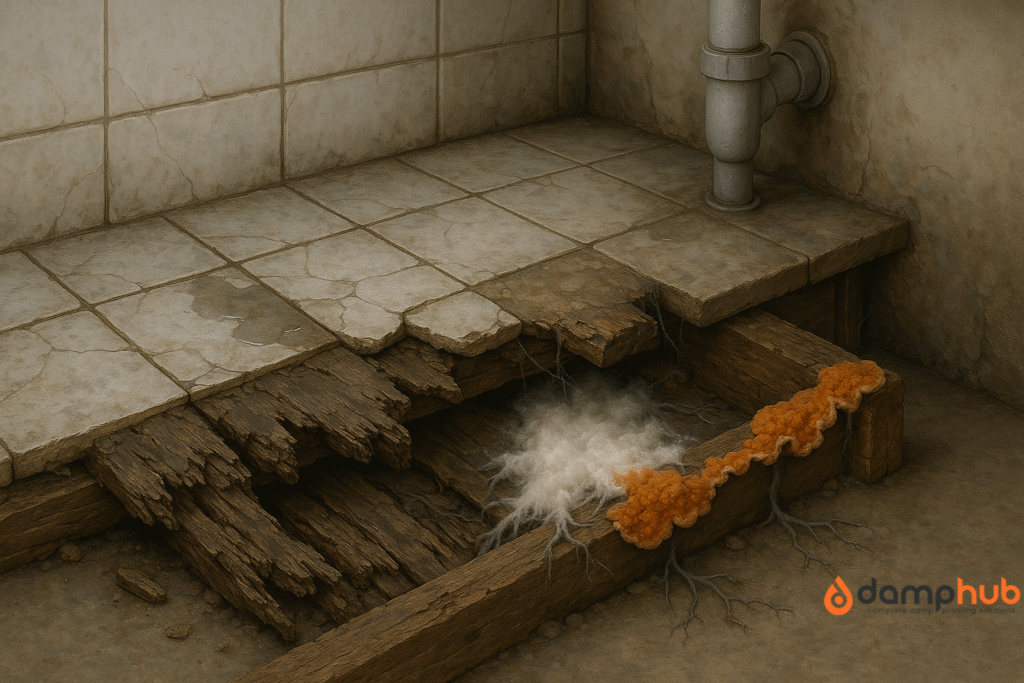
How Long Does It Take For Dry Rot To Form?
In perfect conditions, dry rot can begin developing within 7 to 10 days of moisture exposure. But to fully develop — from invisible spores to destructive mycelium and fruiting bodies — the dry rot lifecycle often takes several weeks to a few months.
It depends on:
- How damp the wood is (anything over 20% moisture is at risk)
- The surrounding temperature (it thrives at 22–26°C)
- Ventilation (poor airflow accelerates growth)
- Timber type and availability (old pine or untreated softwood is most vulnerable)
Even if it appears to have stopped (for example, during a dry summer), dry rot can go dormant. It survives inside timber and can reactivate when moisture returns.
That’s why solving the root cause — not just treating the visible patch — is essential to stopping the dry rot lifecycle from starting up again.
👉 Our helpful guide: Dry Rot Treatment: How to Identify and Eliminate the Problem (UK Guide)
What Are The Four Stages Of Dry Rot?
The dry rot lifecycle moves through four distinct stages, and each one builds on the last. Understanding what’s happening at each stage helps you spot problems early and break the cycle before it becomes a full infestation.
1. Spore Stage
Dry rot starts life as microscopic spores, released by a mature fruiting body. These spores are always present in the air, both indoors and out. They’re not dangerous on their own — and they can sit on timber for months or years without doing anything.
But if they land on wood that’s damp enough, they’ll begin to germinate.
2. Hyphal Growth
Once spores activate, they sprout into tiny white strands called hyphae. These threads penetrate the surface of the timber and begin breaking down the wood’s structure.
This is the most deceptive stage. There’s usually no visible damage on the surface yet — but internally, the wood is starting to weaken. Hyphae continue growing until they form a larger, interconnected network.
3. Mycelium Spread
As the hyphae multiply, they form a dense white or grey network called mycelium. This is the part of the dry rot lifecycle that starts to become visible.
Mycelium looks like a layer of thick cobwebs or cotton wool — often spreading across brickwork, plaster, and pipes in search of new timber to feed on. It’s capable of carrying water and nutrients, helping the fungus colonise new areas even across dry patches.
At this stage, the fungus has gone from “localised issue” to a building-wide threat.
4. Fruiting Body (Sporophore)
When conditions change — especially when the timber dries out — the fungus creates a fruiting body. This is the part that releases spores to continue the cycle.
A dry rot fruiting body is unmistakable:
- Pancake-like or dome-shaped
- Rusty orange in the centre
- Surrounded by grey or white margins
- Often dusted with a fine red-brown powder (the spores)
By this point, the damage is already significant. The fruiting body is the fungus’s last move before going dormant or spreading elsewhere.
What Are The Early Signs Of Dry Rot?
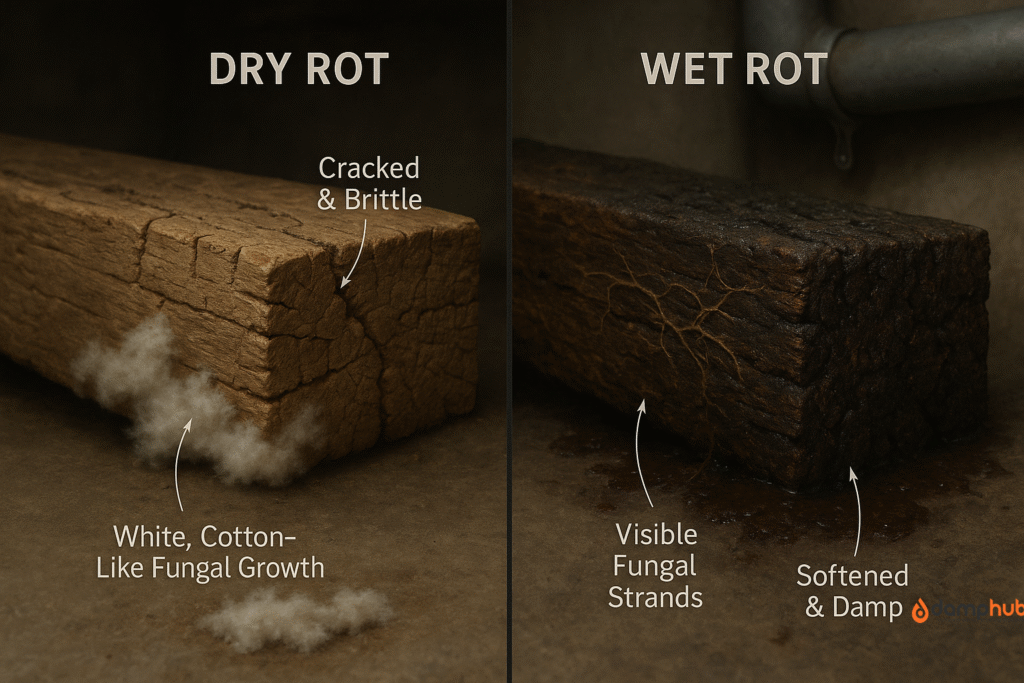
Catching dry rot early is tricky — it’s a hidden fungus by nature. But there are subtle signs you can look for long before structural failure sets in.
Early dry rot signs include:
- A musty, damp, mushroom-like smell, especially in enclosed spaces
- Wood darkening or cracking, often in cube-like patterns (cuboidal cracking)
- White hyphae strands on wood or masonry, especially in voids or corners
- Paint or plaster flaking off, often with damp patches underneath
- Warping, shrinking, or separating timber — skirting boards pulling away, doors no longer closing properly
- Soft or hollow-sounding floorboards, even if they look dry on the surface
👉 Must read: Identifying Dry Rot Symptoms
🟠 Good to know
- ✓ Dry rot can travel across the back of plaster and behind timber panelling. If one spot has it, inspect the area around it thoroughly. These subtle warning signs often appear during the middle of the dry rot lifecycle, when internal damage is already underway but before spores are released.
What Is The Difference Between Rot And Dry Rot?
People often confuse wet rot and dry rot — but they behave very differently. This table breaks it down clearly:
Wet Rot vs. Dry Rot
| Feature | Wet Rot | Dry Rot (Serpula lacrymans) |
|---|---|---|
| Cause | Long-term high moisture (>50%) | Moderate moisture (20–30%) with still air |
| Appearance | Dark, soft, often spongy timber | Brittle, cracked, often cuboidal timber |
| Smell | Damp, earthy | Musty, mushroom-like smell |
| Spread | Localised, limited to damp areas | Spreads through timber and masonry |
| Mycelium / Threads | Rare | White/grey threads often visible |
| Fruiting Body | Rare | Common — orange pancake shape |
| Speed of Growth | Slower | Fast in enclosed, warm areas |
| Treatment Complexity | Isolated removal often enough | Requires aggressive treatment/removal |
🛠️ Try This
- ✓ Tap suspect timber with a screwdriver handle. If it sounds hollow or breaks away easily, and you find cottony strands nearby, dry rot is likely. Knowing the difference between these two fungi helps prevent misdiagnosis and allows faster interruption of the dry rot lifecycle.
How To Inspect For Dry Rot?
A dry rot inspection should be methodical, even if you’re just doing an initial check before calling in a specialist. Dry rot rarely stays in one spot — it follows timber, moves behind walls, and can sit hidden until conditions suit it again.
Here’s how to inspect for dry rot step-by-step:
1. Identify High-Risk Zones
Focus on areas with:
- Long-term damp problems
- Poor ventilation
- Timber touching masonry
- History of leaks or roof issues
Start with: underfloor voids, stairs, built-in cupboards, attic beams, and wall bases.
2. Look For Visible Signs
Use a strong torch and look for:
- White or grey thread-like growths on timber or plaster
- Soft, discoloured, or shrinking wood
- Musty smells
- Fruiting bodies
Gently lift skirting boards or flooring if safe.

3. Use A Moisture Meter
Check timber moisture content:
- Below 15% — safe
- 20–30% — risk zone for dry rot
- Above 30% — almost guaranteed fungal activity
👉 Useful guide: What Percentage Damp Is Acceptable In Walls?
4. Tap-Test The Timber
Lightly knocking on suspect timber is a simple but surprisingly effective way to check for hidden dry rot. Healthy, solid wood will sound firm and give a sharp “knock” or “thunk” when tapped. But timber affected by dry rot often sounds hollow or dull because the internal structure has been eaten away by the fungus.
5. Check Adjacent Materials
Dry rot isn’t picky — it doesn’t just stick to one piece of timber. It can travel through and across different building materials, including walls, plaster, and even brickwork. That’s why when you find one affected beam or joist, you shouldn’t stop there.
Follow the fungus’s trail carefully by checking the surrounding areas. Look behind plasterboard, inside wall cavities, and around brick or masonry where timber might be in contact.
6. Call A Specialist
If you spot anything that looks suspicious — whether it’s visible fungal growth, damp patches, or signs of timber decay — it’s best to bring in a professional timber and damp surveyor. These experts have the tools and know-how to confirm if dry rot is present, assess how far it has spread, and identify the root causes.
A specialist will also recommend the safest and most effective treatment options tailored to your situation. Trying to tackle dry rot yourself can sometimes make things worse or miss hidden damage.
Need help now? Explore our handpicked 10 Best Damp Survey Companies in London
🟠 Good to know
- ✓ Some of the worst dry rot cases come from homeowners patching the surface while leaving the source active. Always trace the problem to its origin.
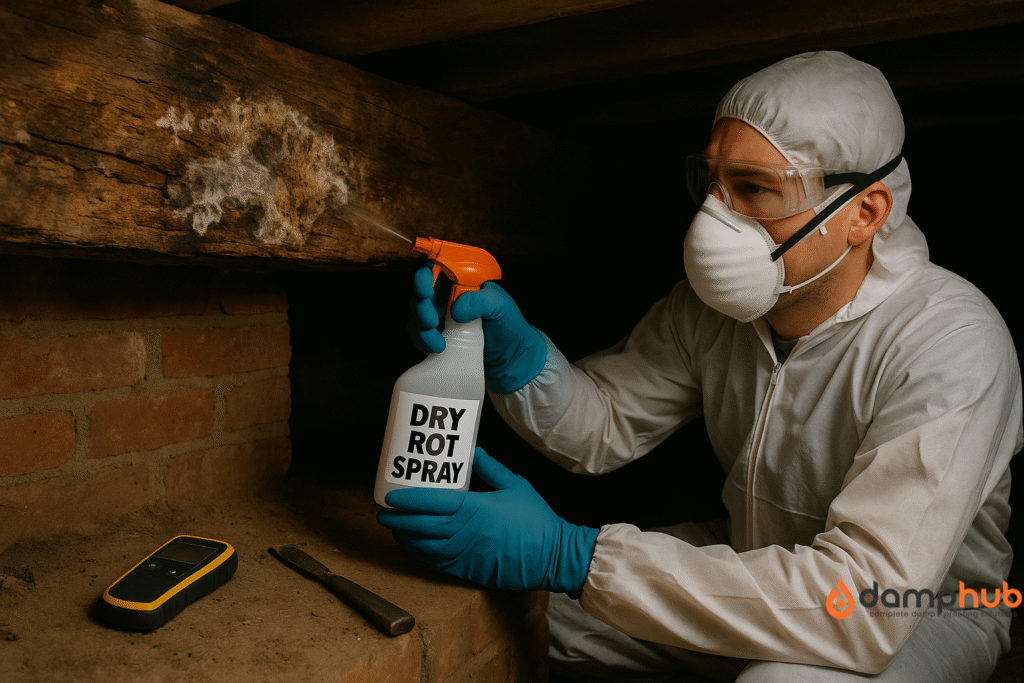
Can You Reverse Dry Rot?
You can’t make damaged timber “undecayed” — but you can stop the lifecycle, clear the infected areas, and rebuild safely.
To stop dry rot properly:
- Fix the moisture issue first — leaks, rising damp, poor airflow
- Remove all affected timber, including anything that shows internal decay
- Treat the surrounding walls and timber with a specialist fungicide
- Allow full drying and ventilation before reinstating finishes
- Use pre-treated timber for any structural repairs
Once the dry rot lifecycle is broken and the area stays dry. It won’t come back. But if you leave any part of it alive, it will.
Is Dry Rot Caused By Water?
Yes — moisture is the trigger for dry rot. Even though it’s called “dry,” it doesn’t happen without damp.
The name “dry rot” just means it needs less moisture than wet rot, but it still needs timber to be above 20% moisture content. The most common sources:
- Leaky roof flashing
- Condensation in poorly ventilated voids
- Rising damp in old walls
- Penetrating damp from defective render or gutters
- Trapped leaks behind kitchens, baths, or WCs
💡 Pro Tip
- ✓ Dry rot loves timber embedded in masonry. Keep those areas well ventilated and check them during any home refurbishment or inspection.
What Happens If Dry Rot Is Left Untreated?
Left alone, dry rot will keep spreading even across dry walls until it runs out of moisture or timber. And it doesn’t need much to keep going.
Consequences of ignoring dry rot include:
- Structural collapse of floors, stairs, joists, or roof timbers
- Full property devaluation — surveyors will flag it instantly
- Costly repairs — you may end up stripping out entire sections of the building
- Reactivation risk — even dried-out dry rot can return if moisture comes back
It’s not just a cosmetic issue. Dry rot is one of the few damp problems that can undermine the actual safety of your home. Dry rot doesn’t go away on its own if left untreated; the dry rot lifecycle will restart anytime conditions return.

Final Thoughts
Look, dry rot isn’t something that appears suddenly overnight. It sneaks in slow and quiet, feeding off damp wood you probably didn’t even know was a problem. If you spot even a hint of it — that weird damp smell, or wood starting to crack or feel soft — don’t ignore it.
Left alone, it spreads quickly and can cause significant damage. The trick is to stop it early by sorting out the damp and getting rid of the affected wood. Once you do that, the rot doesn’t stand a chance. But if you leave it be, it’ll just keep coming back and wrecking things. Simple as that.
Dry Rot Lifecycle: Questions Answered
-
How long does it take for dry rot to spread?
Dry rot can begin spreading within a week if the conditions are right. It typically grows several millimetres to centimetres per day on damp timber and can spread rapidly behind walls or under floors.
-
How to stop the spread of dry rot?
You stop dry rot by eliminating the moisture source and removing infected materials. This usually means fixing leaks, drying out the area, and treating the surrounding timber with a fungicide.
-
Can dry rot spread on clothes?
Yes, dry rot can affect clothes made from natural fibres like cotton, linen, or jute. It’s a type of fungal deterioration that weakens fabric when stored in damp, poorly ventilated conditions — especially vintage or long-stored garments.
-
What does dry rot look like on clothes?
Dry rot in clothes usually shows up as thinning, tearing, or a powdery, brittle texture in the fabric. It often affects older or vintage garments, particularly those stored in damp places, and can make the material tear easily, even with light pressure.
-
What can I spray on dry rot?
You can use a dry rot fungicide spray, usually containing borate or similar agents. These are applied after removing damaged wood and drying the area.
-
When to worry about dry rot?
Worry about dry rot as soon as you spot any signs — like soft timber, musty smells, or visible fungus. Early treatment prevents major structural damage.
-
Can you get sick from dry rot?
Dry rot doesn’t cause illness directly, but the damp environment can trigger mould growth, which may affect people with asthma or allergies.
-
How much dry rot is safe?
No amount of dry rot is considered safe. Even a small area can indicate deeper hidden damage and should be properly inspected and treated.
-
Will dry rot go away on its own?
No, dry rot won’t go away by itself. It stays active or dormant until moisture and food (timber) are removed and the area is treated.
-
How to treat dry rot yourself?
To treat dry rot yourself, begin by damp proofing, removing affected timber, and applying a specialist dry rot fungicide. Always ensure the area stays dry afterwards.


